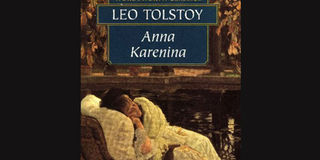What literature shares with mathematics

Just the other day, in the Department of Literature, we saw a film that was based on Leo Tolstoy’s novel Anna Karenina. PHOTO| FILE| NATION MEDIA GROUP
What you need to know:
As I watched it, I thought of the mathematical concept of permutation — the arrangement or combination of things in a definite order. The Russian writer puts together two characters, Anna and Karenin, who are twenty years apart; and the director of this film makes sure Karenin looks visibly older.
Many students who choose to specialise in literature assume they’ve said goodbye to mathematics. Maybe they hated their boring maths teacher, the one who didn’t know how to crack jokes in class. Or maybe they couldn’t stand their prescribed textbook, that one that was written in a turgid, pedantic style.
This “goodbye to maths” is a grand illusion, and avoiding the subject is like trying to jump over your shadow.
Just the other day, in the Department of Literature, we saw a film that was based on Leo Tolstoy’s novel Anna Karenina.
As I watched it, I thought of the mathematical concept of permutation — the arrangement or combination of things in a definite order. The Russian writer puts together two characters, Anna and Karenin, who are twenty years apart; and the director of this film makes sure Karenin looks visibly older.
TRAGIC
The husband is the intellectual, cerebral type; but his wife is this emotional character, ready to die for love. Vronsky, the man who storms into Anna’s life and wrecks her marriage, is a dashing, young military officer; Anna’s lover is also the emotional type, the kind who cannot live with rejection. We can, therefore, see that Tolstoy’s character permutations are the perfect recipe for a great tragic story.
Imagine a situation in which Anna and Karenin are age mates and are of the same temperament. Vronsky would not have intruded into their marriage; and there would have been no story.
A second mathematical concept I want to relate to literature is the so-called Venn diagram, something I came across in 1967 at Friends School Kamusinga.
“Yes, the Venn diagram is about sets, subsets, overlaps, and intersections,” a mathematics professor confirmed to me. One of the most interesting works I taught in my Russian literature class back in 1980s was Alexander Pushkin’s novel in verse called Eugene Onegin.
This book has the story’s arc and the characterisation strategies of a novel; but it takes the form of a series of sonnets. Students of literature know that the sonnet is a fixed lyrical poetic form. Novels are characterised by a discursive expansiveness; and so, what Pushkin does in this verse novel is an absolute miracle.
Flash forward and you encounter Barack Obama’s autobiography called Dreams from My Father. Those who have read this work would agree that it reads like a novel. Obama writes about his life using the story-telling techniques that are associated with fiction; and his linguistic choices are such that they draw attention to themselves. I usually compare it with Wangari Maathai’s Unbowed, an autobiography that makes no pretensions to stylistic elegance.
Obama’s Dreams from My Father, therefore, straddles the two genres of fiction and nonfiction.
The third and most striking mathematical feature in literature is metre. My stylistics students usually stare at me when I tell them about the metrical foot, the “distance” between one stressed syllable and another, and often they wonder whether they’re listening to a lecture in mathematics.
It doesn’t help matters when I ask them to perform oral poems in their mother tongue so that we can all enjoy the beat — which is what metre is about.
Of course, when I tell them that Shakespeare actually counted the metrical feet in his sonnets to ensure that each line had five stressed syllables and five unstressed ones in order to produce a form called the iambic pentameter, many simply get lost.
Finally, how do the two disciplines compare institutionally? In both maths and literature, we pose a problem and we then try to solve it.
Leo Tolstoy asks the question: what happens when a man and a woman who are twenty years apart, and who are temperamentally different, are put together in a permutation called marriage? Further, what happens when you introduce a hot-blooded younger man into this arrangement?
According to the famous author, the answer is — Disaster.
The study of literature can benefit from a mathematical consciousness. I have complained about theories that reduce literature to a branch of sociology.
How about a mathematical theory that takes us back to the texture of literary works?




